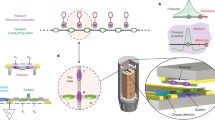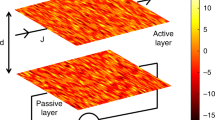Abstract
Coulomb drag is a process whereby the repulsive interactions between electrons in spatially separated conductors enable a current flowing in one of the conductors to induce a voltage drop in the other1,2,3. If the second conductor is part of a closed circuit, a net current will flow in that circuit. The drag current is typically much smaller than the drive current owing to the heavy screening of the Coulomb interaction. There are, however, rare situations in which strong electronic correlations exist between the two conductors. For example, double quantum well systems can support exciton condensates, which consist of electrons in one well tightly bound to holes in the other4,5,6. ‘Perfect’ drag is therefore expected; a steady transport current of electrons driven through one quantum well should be accompanied by an equal current of holes in the other7. Here we demonstrate this effect, taking care to ensure that the electron–hole pairs dominate the transport and that tunnelling of charge between the quantum wells, which can readily compromise drag measurements, is negligible. We note that, from an electrical engineering perspective, perfect Coulomb drag is analogous to an electrical transformer that functions at zero frequency.
 at ν
T = 1.
at ν
T = 1.




Similar content being viewed by others
References
Pogrebinsky, M. B. Mutual drag of carriers in a semiconductor-insulator-semiconductor system. Fiz. Tekh. Poluprovodn. 11, 637–644 (1977); Sov.. Phys. Semicond. 11, 372–376 (1977)
Price, P. M. Hot electron effects in heterolayers. Physica B 117, 750–752 (1983)
Rojo, A. G. Electron-drag effects in coupled electron systems. J. Phys. Condens. Matter 11, R31–R52 (1999)
Snoke, D. Spontaneous Bose coherence of excitons and polaritons. Science 298, 1368–1372 (2002)
Butov, L. V. Exciton condensation in coupled quantum wells. Solid State Commun. 127, 89–98 (2003)
Eisenstein, J. P. & MacDonald, A. H. Bose-Einstein condensation of excitons in bilayer electron systems. Nature 432, 691–694 (2004)
Su, J.-J. & MacDonald, A. H. How to make a bilayer exciton condensate flow. Nature Phys. 4, 799–802 (2008)
Fertig, H. A. Energy spectrum of a layered system in a strong magnetic field. Phys. Rev. B 40, 1087–1095 (1989)
MacDonald, A. H. & Girvin, S. M. in Perspectives in Quantum Hall Effects (eds Das Sarma, S. & Pinczuk, A. ) 161–224 (Wiley, 1997)
Spielman, I. B., Eisenstein, J. P., Pfeiffer, L. N. & West, K. W. Resonantly enhanced tunneling in a double layer quantum Hall ferromagnet. Phys. Rev. Lett. 84, 5808–5811 (2000)
Kellogg, M., Eisenstein, J. P., Pfeiffer, L. N. & West, K. W. Vanishing Hall resistance at high magnetic field in a double-layer two-dimensional electron system. Phys. Rev. Lett. 93, 036801 (2004)
Tutuc, E., Shayegan, M. & Huse, D. A. Counterflow measurements in strongly correlated GaAs hole bilayers: evidence for electron-hole pairing. Phys. Rev. Lett. 93, 036802 (2004)
Wiersma, R. et al. Activated transport in the separate layers that form the ν T = 1 exciton condensate. Phys. Rev. Lett. 93, 266805 (2004)
Yang, S. Hammack, A. T., Fogler, M. M., Butov, L. V. & Gossard, A. C. Coherence length of cold exciton gases in coupled quantum wells. Phys. Rev. Lett. 97, 187402 (2006)
High, A. A. et al. Spontaneous coherence in a cold exciton gas. Nature 483, 584–588 (2012)
Kasprzak, J. et al. Bose-Einstein condensation of exciton polaritons. Nature 443, 409–414 (2006)
Tiemann, L. et al. Exciton condensate at a total filling factor of one in Corbino two-dimensional electron bilayers. Phys. Rev. B 77, 033306 (2008)
Tiemann, L., Dietsche, W., Hauser, M. & von Klitzing, K. Critical tunneling currents in the regime of bilayer excitons. N. J. Phys. 10, 045018 (2008)
Finck, A. D. K., Eisenstein, J. P., Pfeiffer, L. N. & West, K. W. Exciton transport and Andreev reflection in a bilayer quantum Hall system. Phys. Rev. Lett. 106, 236807 (2011)
Eisenstein, J. P., Pfeiffer, L. N. & West, K. W. Independently contacted two-dimensional electron systems in double quantum wells. Appl. Phys. Lett. 57, 2324–2326 (1990)
Spielman, I. B., Eisenstein, J. P., Pfeiffer, L. N. & West, K. W. Observation of a linearly dispersing Goldstone mode in a quantum Hall ferromagnet. Phys. Rev. Lett. 87, 036803 (2001)
Tiemann, L. & Yoon, Y. Dietsche, W. von Klitzing, K. & Wegscheider, W. Dominant parameters for the critical tunneling current in bilayer exciton condensates. Phys. Rev. B 80, 165120 (2009)
Huse, D. A. Resistance due to vortex motion in the ν = 1 bilayer quantum Hall superfluid. Phys. Rev. B 72, 064514 (2005)
Fertig, H. A. &. Murthy, G. Coherence network in the quantum Hall bilayer. Phys. Rev. Lett. 95, 156802 (2005)
Fil, D. V. & Shevchenko, S. I. Interlayer tunneling and the problem of superfluidity in bilayer quantum Hall systems. Low Temp. Phys. 33, 780–782 (2007)
Lee, D. K. K., Eastham, P. R. & Cooper, N. R. Breakdown of counterflow superfluidity in a disordered quantum Hall bilayer. Adv. Condens. Matter Phys. 2011, 792125 (2011)
Pesin, D. A. & MacDonald, A. H. Scattering theory of transport in coherent quantum Hall bilayers. Phys. Rev. B 84, 075308 (2011)
Acknowledgements
We thank A.H. MacDonald and D. Pesin for discussions. This work was supported by NSF grant DMR-1003080.
Author information
Authors and Affiliations
Contributions
D.N., A.D.K.F. and J.P.E. conceived the project. L.N.P. and K.W.W. grew the samples. D.N. and A.D.K.F. performed the experiment and, along with J.P.E., analysed the data and wrote the manuscript.
Corresponding author
Ethics declarations
Competing interests
The authors declare no competing financial interests.
Rights and permissions
About this article
Cite this article
Nandi, D., Finck, A., Eisenstein, J. et al. Exciton condensation and perfect Coulomb drag. Nature 488, 481–484 (2012). https://doi.org/10.1038/nature11302
Received:
Accepted:
Published:
Issue Date:
DOI: https://doi.org/10.1038/nature11302
- Springer Nature Limited
This article is cited by
-
Josephson–Coulomb drag effect between graphene and a LaAlO3/SrTiO3 superconductor
Nature Physics (2023)
-
Thermodynamic behavior of correlated electron-hole fluids in van der Waals heterostructures
Nature Communications (2023)
-
Electrical control of transient formation of electron-hole coexisting system at silicon metal-oxide-semiconductor interfaces
Communications Physics (2023)
-
Signature of quantum interference effect in inter-layer Coulomb drag in graphene-based electronic double-layer systems
Nature Communications (2023)
-
Evidence for equilibrium exciton condensation in monolayer WTe2
Nature Physics (2022)





